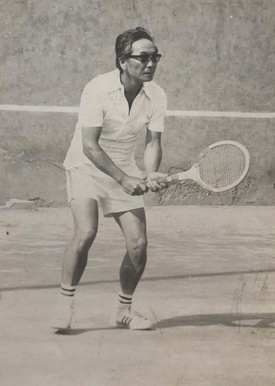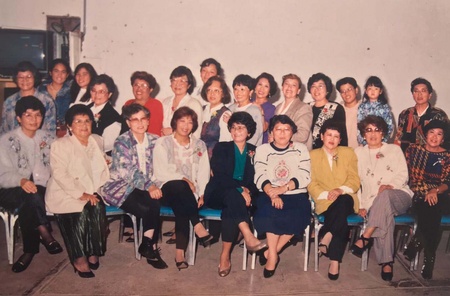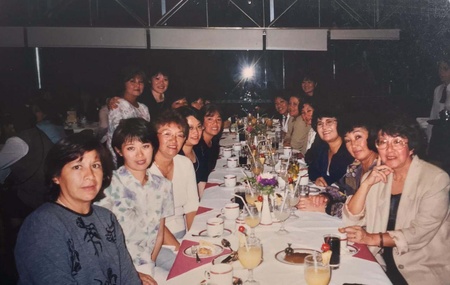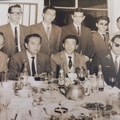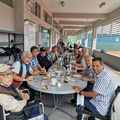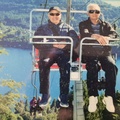Every morning, from my balcony, the AELU postcard gives me hope. The bright green of its fields, the tone of its stands, the rehearsal of its cars in the parking lot, the silence of its classrooms at school and the permanent memory of its members who have left. Far away, I can still see the reddish tennis courts, their long entrance bordered by the cool October grass. That historic path of so many traces of tennis player friends, who made life my passion for a sport and even today, in the looking back of time. There are people who left memories, there are activities that were not forgotten, principles that crowned our ideas and dreams of days that will never return.
The house is still lonely on the holiday of playing a tennis match. This is how Mr. Richard Fukushima remembered him, warm, sincere and helpful. Late arriving and the enka music starting. The ritual of bringing with him the cassette of his passion for Japanese music. He taught us that the affection for our grandparents began there, in making us remember that Casa Linda was an immense stadium (AELU) born from sun to sun, from donation to donation, from visiting our Japanese colony in every corner. of the country, of the isei who barely spoke Spanish, but had the will to open his wallet. And the little ones in times of cleaning up the weeds and overcrowding the challenge of maintaining it and allowing the union to come with their children and grandchildren. Don Richard was able to convince himself, at the end of the road, of the affection and the number of “nephews” who loved him for life.
There were nights of Creole waltzes with the smell of white oil and sawdust. Nights in which the guitars had their own names and staves that were well worth listening to again. And there, in the hall of our memories, where so many times the wind in the company of the clay-colored earth, gave us the notes of someone who could cry and sing.
Fermín Uehara, Luis Fukushima and Aurelio Nakasone formed a trio dedicated to the Creole waltzes of the 1940s. Old people, as many called them, when singing the waltz with heartfelt lyrics, “Hermelinda”, or when someone like me taught us that Felipe Pinglo Alva was still alive singing “El plebeyo” with a long-suffering heart. And only his remembered “The Mirror of My Life” made me see that the Creole waltz never had to die.
We made the tables into a huge row and on top of them, in the fire and passion of the pans, the sukiyaki was born. Divine hands of our ladies who played tennis, those ladies who looked at each other furtively in the rectangle of the courts, who fought for each ball in a first-class serve and who then, apron on their chest, reached the tie break of taste, flavor and kitchen fire.
Dorita Aniya, Isabel Furuya, Anita Duarte, Elsa Fujita, Carmencita de Oka, Shino Hiraoka, Sayo Ykeda, Vicky Kobashikawa, Namy Yrei, Rosa Kanashiro, Gori Oka, Vicky Matsunaka, Rosa Mayeshiro, Marilú Merzthal, Sachiko Mishima, Elisa and Isabel Moromi , Leonor Oka, Viviana Saito. In that constellation, where young ladies learned from older ladies, sukiyaki was the faithful witness on the cold nights of our winter and in the fine essence of our palate.
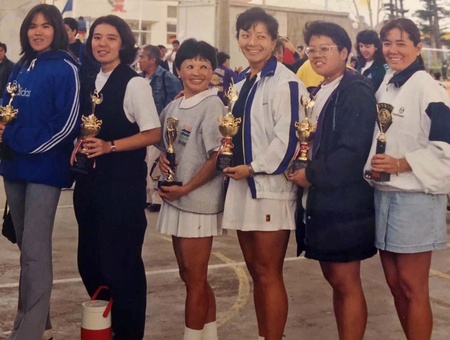
For Mother's Day we were able to purchase pots and flowers in Lurín with Víctor Ykeda, remembered as “Chunchito” from our environment. And we simplify the return after bingeing on 800 grams of pork rinds and ten loaves of bread with four bowls of coffee. Just the two of them. A glorious and festive day, so special that to this day I feel the smell of the mastic and the earth and the authoritative voice of my friend telling me “Come on, Huevito, I don't care how high my cholesterol rises.”
And in the intimate memory of our tennis ladies the end was given and the photo reminds us of that shot from more than 20 years ago. It still remains dormant in our pupils and retains a perfume as unforgettable as that classic container called Chanel #5. Notes in the wind at the scene. And the image does not lie to us, that the absence of many well-known faces, today linked to oblivion, tends to tell us that the march is an end and the memories are the facts.
Tennis always had its own thing. In the simplest and perhaps somewhat spectacular way. We combined sports with any other activity. Singing was and is our primary passion, dancing was simply saying to ourselves “shall we dance?” and we pretended to act like Richard Gere with Jennifer Lopez in the moment of a sensual bolero. But it was tango that made us want to learn it. And Pepe Onaga with Laurita Shimazaki gave us the ritual of a “Little Way” that to this day causes us to stumble when walking.
Dorita Aniya gave us images of the sensual “Mata Hari”, subjugating us with the dance of the seven veils, which made her husband, Dr. Julio Aniya, fall asleep in the fifth veil. And only the popular “Cucharita” grabbed his racket, got his jar, put his card on the first court and gave them, together with three friends, the task that he knew best how to do. Look at the throat like an ENT doctor and play his game of tennis until the buzzer sounded its end.
The photo of the yunza is as classic as my memories of the forest cutting of my beloved and longed-for city of Jauja. Aurelio Nakasone and his classic flying cap bottle known as champagne. Cheerful, festive and ground-based aviator. It was as we called him because of his work at Varig, a Brazilian airline. He was always at AELU Tennis with his “namesake” Teodoro Aragaki, and one day I asked him: “Hey, Aurelio, and why namesake?”, and he told me “Luchito, don't you realize that we are the the only ones we have those names? Aurelio and Teodoro. And, since there is nothing else, the two of us have gotten together. And, whoever likes it, we are there. As our namesakes and as brewers that we are.”
Friends, they say, are like songs. For every taste. And they were. Aurelio was into singing and the guitar and Teodoro was into jokes and sui kao. One Saturday, in Edu's small corner, which looked like a mini restaurant, the two namesakes and the rest of the men binged on more than three hundred sui kaos. It was an outrage that I remember to this day and miss them both again. Aurelio, with his guitar and his deep voice, and Teodoro with his spark in every joke told. Two friends who left almost together on the road to eternity.
Twenty-seven years is a lifetime in counting the fifty minutes that each court turn AELU Tennis gives us to play. Its loud buzzer, its card panel, its intermediate room, its primary talks, its tables full of memories, its shelves of different briefcases and bags, its dressing room of loud laughter, the reddish earth floors, rackets of well-known brands and the wind typical of a friendship that is born in each championship in which one plays. That is AELU Tennis, which becomes a second home and the culmination of a holiday to celebrate.
Today, in the silence of this pandemic, it is well worth remembering, even if our tears well up again and our dreams make us sigh.
Here is a life, happy and well lived!
© 2020 Luis Iguchi Iguchi



